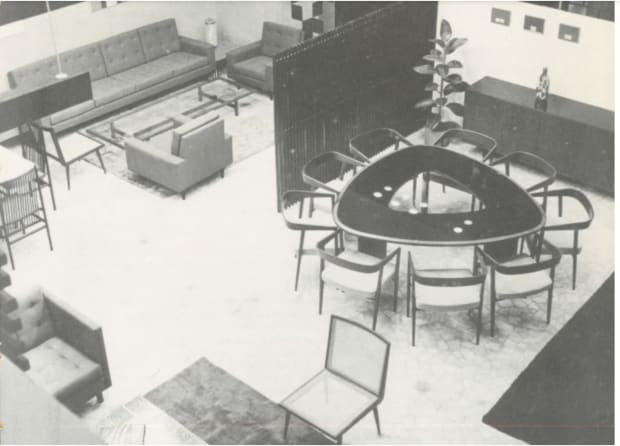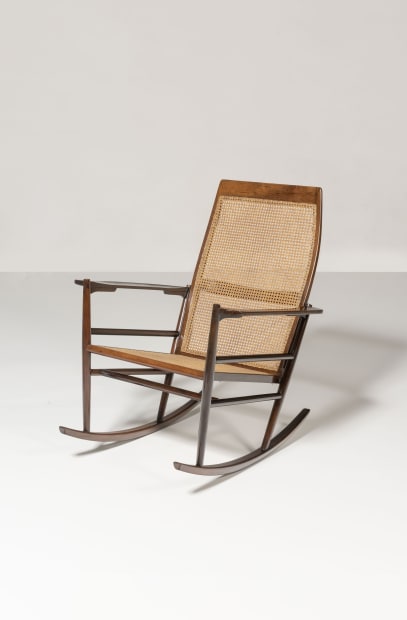-
Considered the founding father of the Brazilian modernist movement, Joaquim Tenreiro is one of the greatest furniture designers in Brazil. His creative work shows a perfect balance between modernism and traditional values as he is also a forerunner in the use of rediscovered raw and local materials.
-

-
 Sideboard, ca. 1960Wood85 x 336 x 50 cm - 33 1/2 x 132 1/4 x 19 3/4 in
Sideboard, ca. 1960Wood85 x 336 x 50 cm - 33 1/2 x 132 1/4 x 19 3/4 in -
This outstanding sideboard impresses by its dimensions and its skillful conception. The massive rectangular cabinet is carried by two delicate rectangular supports. With “lightness” as the key word of his production, Joaquim Tenreiro managed to create a remarkable piece that defies our understanding of gravity.
The quality of the veneer is also remarkable. It presents a dark, strongly veined and very expressive rosewood. The grain was intelligently placed vertically, as if to counterbalance the exceptional width of the piece.
Created in the 1960s as a private order from the designer, this sideboard is a unique piece that was first intended to be mounted directly on the wall. The two feet were added at a later stage.
-

-
 Dining table, ca. 1960Rosewood and glass75 x 183 cm - 29 1/2 x 72 inManufactured by Langenbach & Tenreiro
Dining table, ca. 1960Rosewood and glass75 x 183 cm - 29 1/2 x 72 inManufactured by Langenbach & Tenreiro -
 The Giz de Alfaiate dining table with a set if nine dining chairs in a store in Rua Marquês de Itu, Sao Paulo..
The Giz de Alfaiate dining table with a set if nine dining chairs in a store in Rua Marquês de Itu, Sao Paulo.. -
-
Rare pair of armchairs, c. 1960Rosewood, gray fabric75 x 67 x 81 cm - 29 1/2 x 26 3/8 x 31 7/8 in
-
Exquisitely crafted, this pair of armchairs illustrates Tenreiro’s timeless design that combines simplicity and elegance. Abandoning the rigid profiles and sharp edges of European modernism, he used organic forms and curved lines that can adapt to the human body.
Unlike the heavy furniture that was made at that time, Joaquim Tenreiro was concerned with creating light and ergonomic pieces. He believed that Brazilian furniture had to be ‘formally light … a lightness which has nothing to do with weight itself, but with graciousness and the functionality of spaces.’
-

-
Rare coffee table, ca. 1950Solid caviuna, original glass top25 x 160 x 65 cm - 10 x 63 x 25 1/2 in
-
This rare coffee table is a perfect example of Tenreiro’s modern furniture marked by the sobriety of the designs and the refinement of the form. Favoring artisanal work, Tenreiro’s pieces of furniture were essentially produced in small amounts and generally made to measure for his customer
-
-
Cadeira de Três Pés (Three legs Chair), 1947Laminated and lacquered hardwoods57 x 71 x 69 cm - 22 1/2 x 28 x 27 1/8 in
-
The Three-legged Chair is one of the most recognizable designs by Joaquim Tenreiro and the symbol of the high quality of his craftsmanship. Tenreiro’s great knowledge of the nature of wood and its technical possibilities allowed him to select the highest quality of five Brazilian hardwoods that he combined in this chair to create a truly dynamic effect.
The frame made of different blades of wood strips (rosewood, "roxinho", ivory, imbuya and mahogany), which creates a refined chromatic game; with turned hardwood feet fixed on the seat using the technique of fitting. -
 Oval Coffee Table from solid "trunk" furniture series, 1955Top in Pau Amarelo wood & rosewood feet26 x 171 x 88.8 cm - 10 1/4 x 67 3/8 x 35 inManufactured by Langbach & Tenreiro
Oval Coffee Table from solid "trunk" furniture series, 1955Top in Pau Amarelo wood & rosewood feet26 x 171 x 88.8 cm - 10 1/4 x 67 3/8 x 35 inManufactured by Langbach & Tenreiro -
This remarkable and unique coffee table was created as part of his Tronco (or Trunk ) furniture series. An emblematic work of the designer, this table perfectly illustrated Tenreiro’s spirit. The powerful and sculptural table top in tropical wood highlights the strong Brazilian identity and traditional values that Tenreiro brilliantly combined with modern aesthetics.
Joaquim Tenreiro
Past viewing_room
















